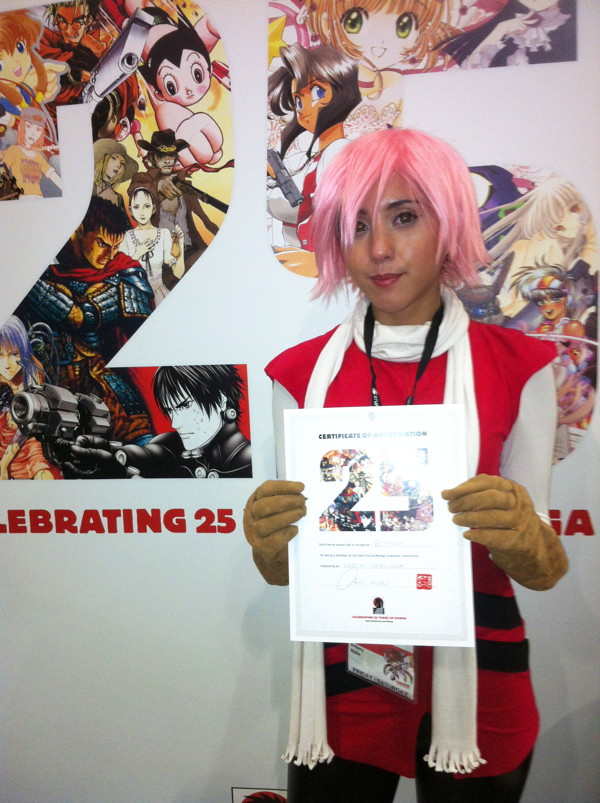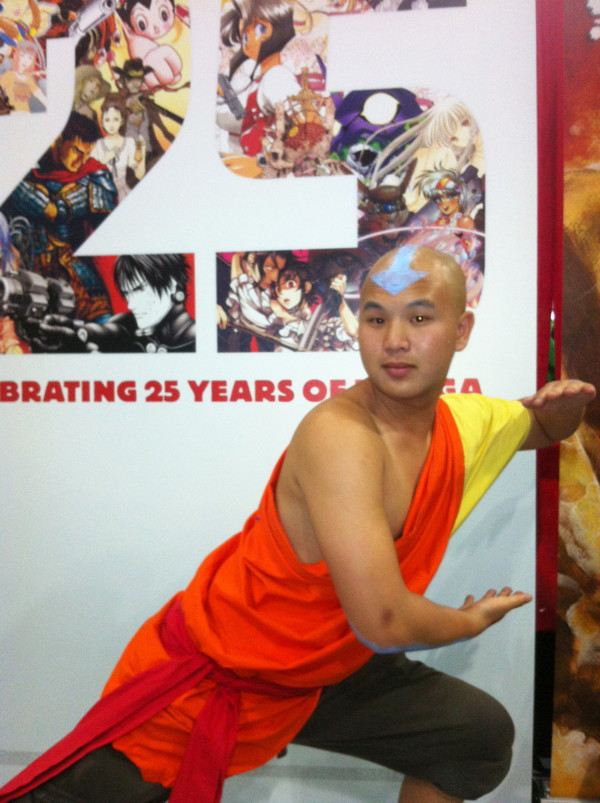Manga Mondays: 2013 Cosplay Album Part 2: Anime Expo!
11/25/2013 1:10pm

I admire Anime Expo; I more than just like it. It has great fan roots: its immediate ancestor, the one-shot AnimeCon ’91, was put together by a coalition including GAINAX (yes, that GAINAX—yes, they helped organize a con for American otaku), the late Toren Smith (whose Studio Proteus was responsible for many of the classic manga published through Dark Horse), and John McLaughlin of BayCon (with whom Toren had worked to create a legendary, film festival-like anime program at BayCon ’86).
BayCon ’86 was a science fiction con; in the 1980s there weren’t yet multiday cons in the US dedicated to anime itself. AnimeCon ’91 aimed to help change that. As an event, it had legendary complications, but nevertheless the very fact the con took place inspired some of the younger people who worked on it, including students from Cal Animage, the anime club of the University of California system that had been founded just two years earlier at Berkeley. In 1992, they regrouped and held the first Anime Expo at the same venue where AnimeCon ’91 had been the year before. In 1994 Anime Expo would move to Southern California, where it has remained since.
1,750 people attended the first Anime Expo in 1992. 61,000 people attended the twenty-second Anime Expo in 2013, and here’s the most important thing—it’s gotten to those numbers while keeping its focus on anime, manga, and their creators, fans, and industry. San Diego Comic-Con is over twice the size, but it draws in fans from all media, including the biggest Hollywood and TV events. By contrast, anime and manga very much remain indie imports—yet their appeal was on display in the massive crowd that thronged to this year’s Anime Expo, held July 4–7 at the Los Angeles Convention Center.
I admire Anime Expo; I more than just like it. It has great fan roots: its immediate ancestor, the one-shot AnimeCon ’91, was put together by a coalition including GAINAX (yes, that GAINAX—yes, they helped organize a con for American otaku), the late Toren Smith (whose Studio Proteus was responsible for many of the classic manga published through Dark Horse), and John McLaughlin of BayCon (with whom Toren had worked to create a legendary, film festival-like anime program at BayCon ’86).BayCon ’86 was a science fiction con; in the 1980s there weren’t yet multiday cons in the US dedicated to anime itself. AnimeCon ’91 aimed to help change that. As an event, it had legendary complications, but nevertheless the very fact the con took place inspired some of the younger people who worked on it, including students from Cal Animage, the anime club of the University of California system that had been founded just two years earlier at Berkeley. In 1992, they regrouped and held the first Anime Expo at the same venue where AnimeCon ’91 had been the year before. In 1994 Anime Expo would move to Southern California, where it has remained since.
1,750 people attended the first Anime Expo in 1992. 61,000 people attended the twenty-second Anime Expo in 2013, and here’s the most important thing—it’s gotten to those numbers while keeping its focus on anime, manga, and their creators, fans, and industry. San Diego Comic-Con is over twice the size, but it draws in fans from all media, including the biggest Hollywood and TV events. By contrast, anime and manga very much remain indie imports—yet their appeal was on display in the massive crowd that thronged to this year’s Anime Expo, held July 4–7 at the Los Angeles Convention Center.

Crowding somewhere in that throng were Dark Horse and its Anime Expo contingent: booth manager Topher Alford, retail manager Sarah Robertson, press coordinator Aub Driver, and editors Philip Simon and Carl Horn. Like San Diego Comic-Con, Anime Expo—AX for short—has a well-organized free shuttle bus route that covers the area hotels. But we decided to take the subway, which we’d seen in Predator 2 (the poster is upstairs at Dark Horse, next to the microwave: “HE’S IN TOWN WITH A FEW DAYS TO KILL”); it was across the street from the hotel and the convention center was only one stop down the line.
The movie’s depiction of a future Los Angeles dominated by menacing gangs was not entirely inaccurate, but they warmed up quickly once we explained that Dark Horse published Avatar: The Last Airbender and The Legend of Korra. Aha, you say—I thought you just wrote something about Expo keeping a focus on anime. Well, so did Avatar; as director Giancarlo Volpe said at the 2006 San Diego Comic-Con, “We all were ordered to buy FLCL and watch every single episode of it.”

Which, by coincidence, we also publish. Avatar is a very creative work in its own right; one of the things I especially admire about the series is the wide inspiration its fantasy world takes from the highly diverse cultures along the Pacific Rim. Tolkien was a scholar of the European cultures that inspired The Lord of the Rings; part of the adventure of fantasy can be the real journey toward a better understanding of the reality behind the myth.

A theme that struck me in Gene Luen Yang’s Avatar: The Last Airbender—The Promise was Aang at first being pleased by fans trying to emulate the look and form of his culture’s traditions, but then realizing a culture has to be lived, and the difficulty of trying to preserve it alone in a world where cultures constantly compete. We might casually say a word such as Asian or European, but Asia, like Europe (and everywhere else) has within it some cultures that are large and strong, and some that are small and struggling—societies that might be thousands of years old, but that have dwindled to only a handful of people who still know its languages and traditions.

It’s not surprising that there are so many crossover fans of Avatar and anime, because Avatar also represents perhaps the best thing any foreign fan of anime can take from the medium—the inspiration to create something new and exciting of their own, keeping the creative cycle going. Princess Azula also dropped by to remark, “I’m—how do you say…? Paranoid.” No, wait, that was Tony Montana. You think that’s not anime either? Go ask Garterbelt!

To quote a South Central native, “Let ’em see a Miku invasion,” and as we gear up for our Hatsune Miku: Unofficial Hatsune Mix manga omnibus in 2014, we saw it all right, as Vocaloids mobbed our booth. Clockwise from upper left, it was Kagamine Rin, Akita Neru, Hatsune Miku, and Hatsune Miku again!

We wanted to show this almost Moses-like image of Link holding Hyrule Historia, because, while we also sold out of The Sky: The Art of Final Fantasy Slipcased Edition (in fact, our booth at AX was the first place you could buy it!), I don’t think it’s even possible to hold it above your head like that. I was amazed to see not one, but two people on the train platform going home, hauling their own box sets of The Sky. That will get you in shape for an adventure quest in no time.
As you might guess, it was a very successful Anime Expo for us, but we’d especially like to thank all the people (both fans and industry) who welcomed us back there, and who came to our events. Josh Kocurek of Funimation sat in on the Evangelion panel together with Dark Horse and helped get a great discussion going with the audience. Viz was kind enough to give an invitation to an industry panel, ANN to a party, and Production I.G to a presentation, and I even got to talk with H-Town’s finest, Sentai Filmworks. Really, it felt like a homecoming—so much happened that we’re saving some for next week!
—Carl Horn, Manga Editor



